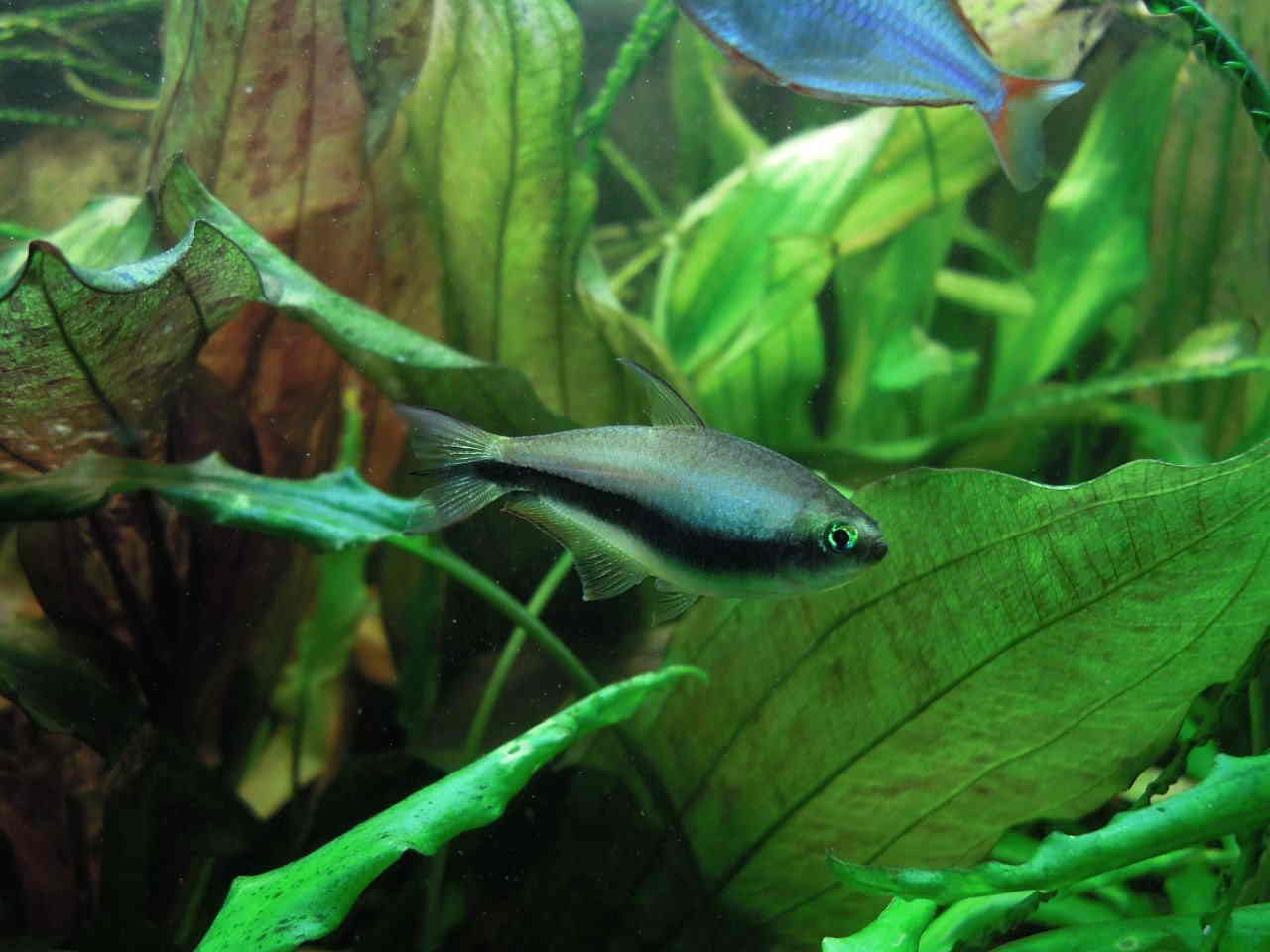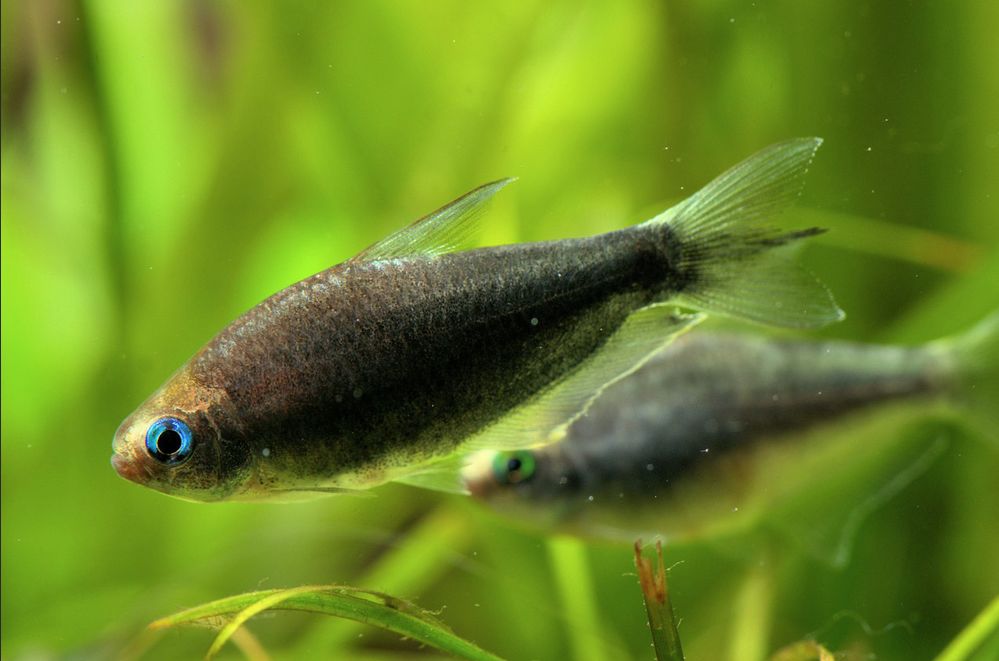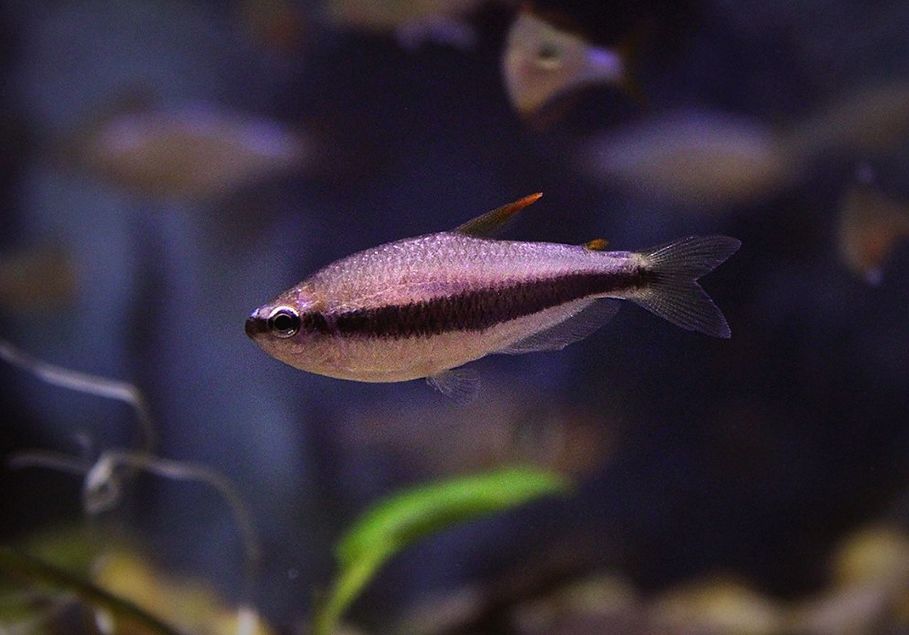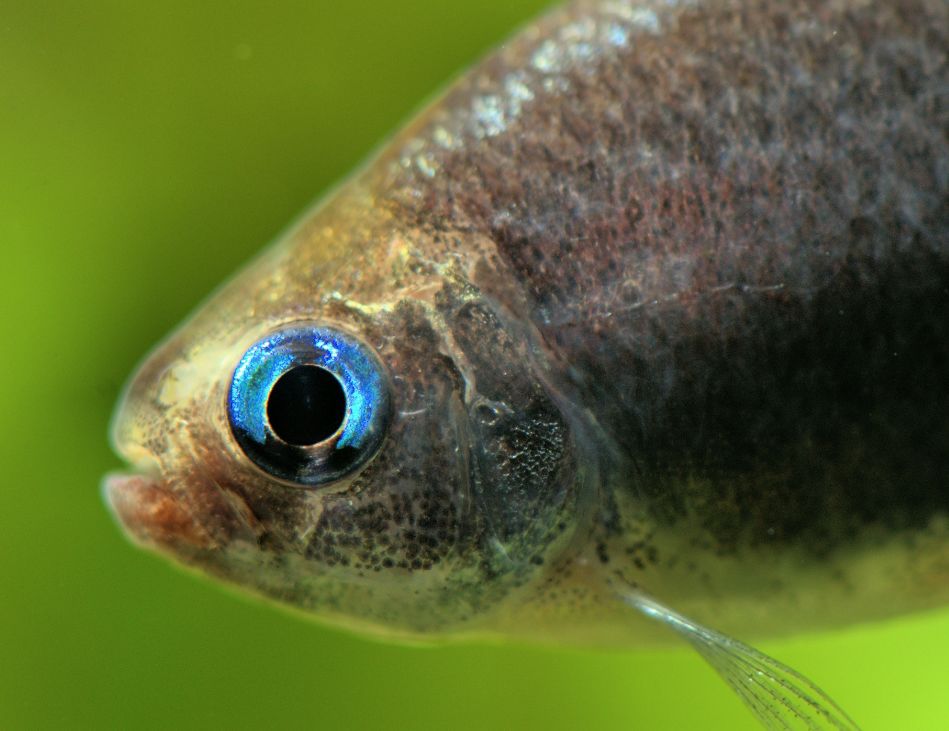The emperor tetra is a popular choice among freshwater aquarium enthusiasts due to its striking appearance and peaceful nature. This small, colorful fish thrives in community tanks, particularly those that are densely planted. A well-maintained aquarium not only enhances their vibrant colors but also provides the ideal environment for their natural behaviors.
To promote a healthy and thriving community, it’s best to keep emperor tetras in small schools of six or more. This grouping encourages social interactions and can even lead to breeding, making them an engaging addition to your aquarium.

Contents
Habitat in the wild
The emperor tetra, a member of the Characidae family, is a striking freshwater fish favored by aquarium enthusiasts. This diverse family, commonly known as characins or tetras, includes well-known species such as neon tetras, cardinal tetras, black skirt tetras, and serpae tetras.
Endemic to the San Juan and Atrato rivers in Colombia, emperor tetras inhabit the slow-moving waters of the Amazon Basin, often found in small tributaries and streams rich in dense vegetation. Their natural environment features blackwater or clearwater conditions, where the water is typically acidic and soft, with pH levels ranging from 6.0 to 7.5. The dark, tea-colored water results from tannins leached from decaying organic matter, creating a unique habitat.
In the wild, emperor tetras thrive among submerged plants and floating vegetation, which provide essential cover and breeding sites. They prefer areas with low to moderate light intensity, crucial for their comfort and safety. These fish coexist with a variety of species, contributing to the rich biodiversity of the Amazon and forming part of a complex food web.
While emperor tetras are not widely distributed in the wild, they are commonly found in hobbyist tanks, as most available specimens are bred in farms for commercial purposes. With proper care, they can flourish and bring a vibrant touch to any aquarium.

Description
Emperor tetras are relatively small fish, typically reaching a length of 2 to 2.5 inches (5 to 6 cm). Males are usually slightly larger and display more vibrant colors. Their slender, elongated bodies and flowing fins create a graceful appearance that enhances any aquarium setting.
The average lifespan of emperor tetras in captivity ranges from 3 to 5 years, although some individuals may live longer with optimal care. Their bodies are somewhat flattened from the sides, with a notably curved backline. The fish features a dark blue coloration on the sides, complemented by an expressive emerald-blue eye. The proctal fin is distinguished by a black line and yellow edges, while the dorsal fin displays black on its outer rays and the first ray.
A selectively bred variation, known as the black emperor tetra, showcases a striking black body while maintaining the same slender shape as the standard variety. These fish exhibit varying intensities of black coloration, from deep black to charcoal or dark gray. The black emperor tetra is increasingly popular among hobbyists for its unique and eye-catching appearance, making it a valuable addition to aquariums.
| Characteristic | Description |
|---|---|
| Scientific Name | Nematobrycon palmeri |
| Common Name | Emperor Tetra |
| Origin | Amazon Basin (Colombia) |
| Size | 2-2.5 inches (5-6 cm) |
| Lifespan | 3-5 years |
| Water Parameters | Soft to moderately hard water, pH 6.0-7.5 |
| Temperature Range | 75-82°F (24-28°C) |
| Aquarium Size | 20 gallons (75 liters) or larger |
| Behavior | Peaceful, schooling fish |
| Coloration | Iridescent blue-green upper body, red or orange lower body |
| Diet | Omnivorous, accepts flake or pellet foods; supplement with live or frozen foods |
| Compatibility | Peaceful community fish, best kept in groups of 6 or more |
| Breeding | Egg-scatterers, remove adults after spawning, eggs hatch in 24-36 hours |

Difficulties in keeping
Caring for emperor tetras is relatively easy, making them an excellent choice for both novice and experienced aquarists. These fish are not demanding and thrive in community tanks. However, it’s crucial to remember that they are schooling fish; therefore, it’s best to keep them in groups of six or more to promote their social behaviors and well-being.
Care and keeping in a tank
Tank size
When caring for emperor tetras, providing an appropriate tank size is crucial. It is recommended to use a tank of at least 20 gallons (75 liters) or larger. This size allows for ample swimming space and creates a comfortable environment for a small school of emperor tetras. While a couple can be housed in a 10-gallon tank, keeping a group of six or more in a 20 to 40-gallon tank is preferable, with a focus on having more females to promote a harmonious community.
Emperor tetras are active fish that enjoy open swimming areas as well as spaces filled with vegetation and hiding spots. A spacious tank enables them to exhibit natural behaviors and reduces stress within the group.
Tank Decor
Incorporating live plants enhances the aquarium environment. Suitable plants include Amazon Sword, Java Fern, Java Moss, and Anubias. These not only provide cover and shaded areas but also contribute to the tank’s aesthetics. Adding floating plants like Water Sprite, Duckweed, or Amazon Frogbit can further create a sense of security for the emperor tetras.
These fish prefer tanks with plenty of plants and soft lighting, reflecting their natural habitat in the rivers of Colombia. Using a dark substrate, such as sand or fine gravel, can enhance their colors and create a more appealing appearance. Additionally, adding driftwood or bogwood can help replicate their natural environment, offering hiding spots and releasing tannins that mimic the blackwater or clearwater conditions they are accustomed to.
Water Parameters
Emperor tetras thrive in clean, regularly maintained water, and they require peaceful tank mates and a varied diet. Originating from the Amazon Basin, they are accustomed to soft, slightly acidic to neutral water. Although they have adapted to various water parameters due to breeding, the ideal conditions are:
- Temperature: 75-82°F (24-28°C)
- pH: 6.0-7.5
- Hardness: Soft to moderately hard water (2-15 dGH)
Ensure adequate filtration to maintain water quality and oxygenation. Regular partial water changes of around 20% every 1-2 weeks will help maintain optimal conditions and remove accumulated waste.

Diet
Emperor tetras are omnivorous fish with a relatively flexible diet. In their natural habitat, they primarily feed on small insects, zooplankton, and plant matter. In the aquarium, they readily accept a variety of foods, making it easy to meet their nutritional needs.
A suitable staple diet for emperor tetras includes high-quality commercial flake or pellet foods formulated for tropical fish. Look for products that offer a balanced nutritional profile, containing a mix of proteins, vitamins, and minerals. Feed them small portions a few times a day, ensuring they consume the food within a few minutes to prevent water contamination.
To provide variety and additional nutrients, supplement their diet with live or frozen foods. Options such as brine shrimp, daphnia, bloodworms, and mosquito larvae closely mimic their natural diet and are usually eagerly accepted. Offering live or frozen foods as a treat 2-3 times a week can enhance their overall health and coloration.
Tank mates
Emperor tetras are territory-dependent fish, which means that in a school, there is typically one alpha male who claims the largest territory. This dominant male exhibits distinct behavior when guarding his territory; he swims with a slight forward lean, raising his tail at a 45-degree angle, which resembles a crown. This display serves both as a warning to other males and as a way to attract females.
Despite their territorial nature, emperor tetras are generally active and peaceful fish. Their vibrant colors contrast beautifully with many other brightly colored species, making them a stunning addition to community tanks.
Tank mates can be guppies, swordtails, zebra danio, other tetras and peaceful catfish species like Corydoras.
You should avoid large fishes as tank mates – like flowerhorn or green terror which will consider tetras as feed.
Here are some examples of suitable tank mates for emperor tetras:
- Harlequin Rasboras (Trigonostigma heteromorpha)
- Neon Tetras (Paracheirodon innesi)
- Ember Tetras (Hyphessobrycon amandae)
- Glowlight Tetras (Hemigrammus erythrozonus)
- Black Neon Tetras (Hyphessobrycon herbertaxelrodi)
- Cardinal Tetras (Paracheirodon axelrodi)
- Rummy Nose Tetras (Hemigrammus rhodostomus)
- Dwarf Gouramis (Trichogaster lalius or Trichogaster chuna)
- Sparkling Gouramis (Trichopsis pumila)
- Celestial Pearl Danios (Danio margaritatus)
- White Cloud Mountain Minnows (Tanichthys albonubes)
- Dwarf Rasboras (Boraras spp.)
- Endler’s Livebearers (Poecilia wingei)
- Guppies (Poecilia reticulata)
- Platies (Xiphophorus spp.)
- Corydoras Catfish (Corydoras spp. – pygmy cory, panda cory, adolfoi catfish)
- Otocinclus Catfish (Otocinclus spp.)
- Bristlenose Plecos (Ancistrus spp.)

Gender differences: male vs female
Understanding the differences between male and female emperor tetras is essential for successful breeding and maintaining a balanced aquarium. Here are the general characteristics to help distinguish between the two:
Male Emperor Tetras
- Size: Males tend to be slightly larger than females, exhibiting a more elongated and robust body shape.
- Coloration: Males display more intense and vibrant colors, with a vivid blue-green upper body and brighter red or orange lower body, especially during breeding.
- Fin Length: The dorsal fin of males is typically more elongated and prominent, contributing to their elegant appearance.
Female Emperor Tetras
- Size: Females are generally smaller and more slender compared to males.
- Coloration: Female coloration is usually less intense, with a muted blue-green upper body and less pronounced red or orange on the lower body.
- Fin Length: The dorsal fin of females is shorter and less extended than that of males.
While these differences are generally consistent, they can vary between individuals and may not be as pronounced in younger or less mature specimens. The distinctions often become more noticeable during breeding season when males display intensified colors and engage in courtship behaviors.
Breeding
Emperor tetras reach reproductive maturity around six months of age. For breeding, a minimum tank length of 60 cm is recommended for one male and two to three females. It is essential to introduce multiple females to prevent aggression; a male can harm a female if she is not ready to spawn.
A breeding tank should include plants such as Java moss, Myriophyllum, or Elodea to provide hiding spots and spawning surfaces. The ideal water parameters for breeding are:
- General Hardness: 1-5°
- Temperature: 24-28°C
- pH: 6.0-6.8
Although eggs thrive in slightly more acidic and soft water, juveniles are susceptible to illness in such conditions. Before spawning, it’s advisable to keep the alpha male separate from the females for several weeks. When introduced to the breeding tank in the evening, spawning typically occurs the following morning.
During spawning, a female can lay between 50 to 150 large, transparent eggs. After spawning, both parents should be removed from the breeding tank to prevent them from eating the eggs. Reducing the water level to 5-8 cm in the breeding tank and shading it can help protect the eggs.
Juveniles usually hatch within 1-2 days and begin swimming about 4-6 days later. Initially, they should be fed infusoria, followed by brine shrimp nauplii on the second day.